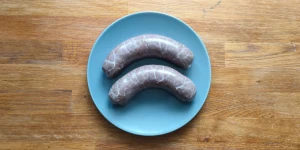
Kaszanka - polish blood sausage
Jump to recipe
Today we will present a rather unusual dish - Kaszanka. This is one of the quite characteristic meat products. Due to its composition, many people may find it strange and even repulsive. Yet, it finds its connoisseurs not only in Poland. This unusual meat product includes, among others, groats, selected offal and... blood. And it is this last ingredient that often discourages you from trying it - although unnecessarily.
Kaszanka is a type of blood sausage also known under other names, such as 'kiszka kaszana', 'krupnioki śląskie' or 'kaszok'. Some people simply call it 'Kiszka', but the word itself is more general. There are other types of kiszka, such as 'kiszka ziemniaczana' (potato kiszka).
Depending on the region of Poland, the recipe or composition may vary slightly. The recipe here is rather more uniform. It is based on a recipe included in one of the Polish books on regional cuisine.
Apart from Poland, this product is also known in many cuisines of Central and Eastern Europe. We can also find it in Slovak cuisine (Jaternica), Czech cuisine (Jelito), Ukrainian cuisine (Krovyanka), Hungarian cuisine (Véres hurka) and in German cuisine (Grützwurst). Each of these cuisines has its unique recipe, often differing in additions or spices. However, the base is similar.
In Poland, 'krupnioki śląskie' obtained the European Protected Geographical Indication certificate in June 2016, confirming their uniqueness. It is said to be very similar to black pudding, but it is a product unique to this region.
How was Kaszanka created?
Although Kaszanka has become an integral part of Polish cuisine today. It most likely came here from Germany or the Czech Republic via Silesia. But, various sources attribute it to a slightly different direction - more south-eastern.
Some of the oldest records about this dish can be found in the diaries of Jan Chrysostom Pasek from the 17th century. They show that it was already quite popular back then. In the 19th century, numerous historical records already testify to the ubiquity of this meat.
These delicious cold cuts were becoming more and more popular on country tables. People working hard in the fields needed caloric and nutritious meals. This made blod sausage not only a tasty dish but also an important element of the diet for rural residents.
The production of kaszanka was inextricably linked to pig slaughter. During it, all family members were involved, and the butcher acted as a kind of master of the ceremony. The blood obtained during slaughter was a valuable ingredient for the production of not only kaszanka, but also brawn.
Villagers often used all possible parts of the animal. Therefore, significant amounts of kaszanka were produced to be shared with the entire family as well as with neighbors. Sharing cold meats was not only a tradition but also economically profitable. It allowed for optimal use of pork offal so that nothing was wasted.
Recipe informations:
Ingredients
- 1 kg of pork lungs
- 2 kg of pork fat
- 1 kg of small groats
- 1 kg of pork liver
- 50 dag of pork kidneys
- 50 dag of pork heart
- 30 dag of pork pancreas
- 1 liter of pig blood
- pepper
- salt to taste
- thick pig intestines, about 50 cm long
